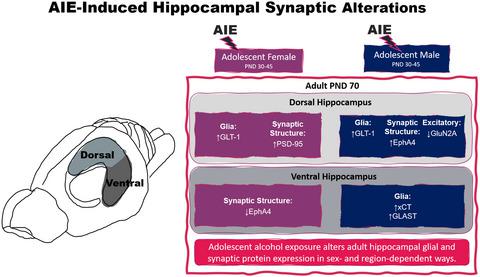当前位置:
X-MOL 学术
›
J. Neurosci. Res.
›
论文详情
Our official English website, www.x-mol.net, welcomes your
feedback! (Note: you will need to create a separate account there.)
Effects of adolescent intermittent ethanol on hippocampal expression of glutamate homeostasis and astrocyte-neuronal tethering proteins in male and female rats
Journal of Neuroscience Research ( IF 2.9 ) Pub Date : 2020-11-20 , DOI: 10.1002/jnr.24758 Kati L Healey 1 , Sandra Kibble 1 , Amelia Bell 1 , Sierra Hodges 1 , H Scott Swartzwelder 1
Journal of Neuroscience Research ( IF 2.9 ) Pub Date : 2020-11-20 , DOI: 10.1002/jnr.24758 Kati L Healey 1 , Sandra Kibble 1 , Amelia Bell 1 , Sierra Hodges 1 , H Scott Swartzwelder 1
Affiliation

|
Adolescent alcohol drinking is widely recognized as a significant public health problem, and evidence is accumulating that sufficient levels of consumption during this critical period of brain development have an enduring impact on neural and behavioral function. Recent studies have indicated that adolescent intermittent ethanol (AIE) exposure alters astrocyte function, astrocyte–neuronal interactions, and related synaptic regulation and activity. However, few of those studies have included female animals, and a broader assessment of AIE effects on the proteins mediating astrocyte-mediated glutamate dynamics and synaptic function is needed. We measured synaptic membrane expression of several such proteins in the dorsal and ventral regions of the hippocampal formation (DH, VH) from male and female rats exposed to AIE or adolescent intermittent water. In the DH, AIE caused elevated expression of glutamate transporter 1 (GLT-1) in both males and females, elevated postsynaptic density 95 expression in females only, and diminished NMDA receptor subunit 2A expression in males only. AIE and sex interactively altered ephrin receptor A4 (EphA4) expression in the DH. In the VH, AIE elevated expression of the cystine/glutamate antiporter and the glutamate aspartate transporter 1 (GLAST) in males only. Compared to males, female animals expressed lower levels of GLT-1 in the DH and greater levels of ephrin receptor B6 (EphB6) in the VH, in the absence of AIE effects. These results support the growing literature indicating that adolescent alcohol exposure produces long-lasting effects on astrocyte function and astrocyte-neuronal interactions. The sex and subregion specificity of these effects have mechanistic implications for our understanding of AIE effects generally.
中文翻译:

青春期间歇性乙醇对雄性和雌性大鼠海马谷氨酸稳态和星形胶质细胞-神经元束缚蛋白表达的影响
青少年饮酒被广泛认为是一个重大的公共卫生问题,并且越来越多的证据表明,在大脑发育的这个关键时期,足够的饮酒水平对神经和行为功能具有持久的影响。最近的研究表明,青少年间歇性乙醇 (AIE) 暴露会改变星形胶质细胞功能、星形胶质细胞-神经元相互作用以及相关的突触调节和活动。然而,这些研究很少包括雌性动物,需要更广泛地评估 AIE 对介导星形胶质细胞介导的谷氨酸动力学和突触功能的蛋白质的影响。我们测量了海马结构背侧和腹侧区域中几种此类蛋白质的突触膜表达(DH,VH) 来自暴露于 AIE 或青春期间歇性水的雄性和雌性大鼠。在 DH 中,AIE 导致男性和女性中谷氨酸转运蛋白 1 (GLT-1) 的表达升高,仅女性中突触后密度 95 表达升高,仅男性中 NMDA 受体亚基 2A 表达减少。AIE 和性交互改变了 DH 中肝配蛋白受体 A4 (EphA4) 的表达。在 VH 中,AIE 仅在男性中提高了胱氨酸/谷氨酸逆向转运蛋白和谷氨酸天冬氨酸转运蛋白 1 (GLAST) 的表达。在没有 AIE 效应的情况下,与雄性动物相比,雌性动物在 DH 中表达较低水平的 GLT-1,在 VH 中表达更高水平的肝配蛋白受体 B6 (EphB6)。这些结果支持越来越多的文献表明,青少年酒精暴露对星形胶质细胞功能和星形胶质细胞-神经元相互作用产生长期影响。这些效应的性别和亚区域特异性对我们对 AIE 效应的一般理解具有机制意义。
更新日期:2020-11-20
中文翻译:

青春期间歇性乙醇对雄性和雌性大鼠海马谷氨酸稳态和星形胶质细胞-神经元束缚蛋白表达的影响
青少年饮酒被广泛认为是一个重大的公共卫生问题,并且越来越多的证据表明,在大脑发育的这个关键时期,足够的饮酒水平对神经和行为功能具有持久的影响。最近的研究表明,青少年间歇性乙醇 (AIE) 暴露会改变星形胶质细胞功能、星形胶质细胞-神经元相互作用以及相关的突触调节和活动。然而,这些研究很少包括雌性动物,需要更广泛地评估 AIE 对介导星形胶质细胞介导的谷氨酸动力学和突触功能的蛋白质的影响。我们测量了海马结构背侧和腹侧区域中几种此类蛋白质的突触膜表达(DH,VH) 来自暴露于 AIE 或青春期间歇性水的雄性和雌性大鼠。在 DH 中,AIE 导致男性和女性中谷氨酸转运蛋白 1 (GLT-1) 的表达升高,仅女性中突触后密度 95 表达升高,仅男性中 NMDA 受体亚基 2A 表达减少。AIE 和性交互改变了 DH 中肝配蛋白受体 A4 (EphA4) 的表达。在 VH 中,AIE 仅在男性中提高了胱氨酸/谷氨酸逆向转运蛋白和谷氨酸天冬氨酸转运蛋白 1 (GLAST) 的表达。在没有 AIE 效应的情况下,与雄性动物相比,雌性动物在 DH 中表达较低水平的 GLT-1,在 VH 中表达更高水平的肝配蛋白受体 B6 (EphB6)。这些结果支持越来越多的文献表明,青少年酒精暴露对星形胶质细胞功能和星形胶质细胞-神经元相互作用产生长期影响。这些效应的性别和亚区域特异性对我们对 AIE 效应的一般理解具有机制意义。











































 京公网安备 11010802027423号
京公网安备 11010802027423号